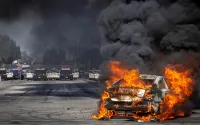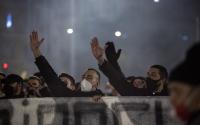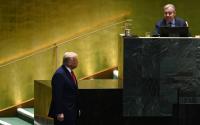Fernand Braudel Center, Binghamton University List of previous commentaries in English and translations in other languagesCommentary No. 159 (corrected version), April 15, 2005
The extraordinary celebration of John Paul II at his funeral, whose only comparable event in the last fifty years was the funeral of John F. Kennedy in 1963, has led to many reflections on the role of this pope, and that of the papacy in general, in world history. The pope was celebrated more or less equally by George W. Bush, Fidel Castro, and Jacques Chirac, by Israeli and Palestinian leaders, and by clerics from all the world's religious institutions, which, even given the usual outpouring on such occasions, seems remarkable. As for the Catholic Church, it is now approaching its two-thousandth year of existence as an institution, which no other structure of any kind can match. It leads one to remember the perhaps apocryphal statement of the great French diplomat of the beginning of the nineteenth century, Talleyrand, who is supposed to have responded to the question of what he did during the Revolution and the Terror with the answer, j'ai survécu (I survived).
The Catholic Church has indeed survived the most incredible series of transformations of world social structures over two millennia. How has it been able to do it? I would say by paying close attention to two questions: how the Church should relate to political authorities; and what the Church needs to do to hold itself together. John Paul II was deeply concerned with both these questions, and his unusually long papacy (only one pope ever served longer) consisted of a long series of acts that responded to these concerns.
The Church, as we know, passed its first three centuries as a pariah group of faithful, fiercely persecuted by the Roman authorities. But in the beginning of the fourth century, the emperor Constantine converted to Christianity, which then became the official religion of the Roman Empire. One of the early acts of Constantine was to convene the Council of Nicaea in 325, at which the bishops proclaimed Arianism (a doctrine that denied the divinity of Christ) to be heresy and defined the basic theological doctrine of the holy trinity that has guided the Catholic Church ever since.
The Church had at this point created a firm hierarchical structure and affirmed a clearly-defined set of dogmas. On this basis, the Church was able to survive and thrive until the beginning of the modern world-system in the sixteenth century. Its evangelical activities reached successfully all of Europe, but only slightly beyond Europe. During all this period, the Church existed primarily within political structures that were governed by Christian rulers. It did suffer the great schism with the Orthodox churches in the eleventh century, one of the basic divisive issues being the primacy of the Bishop of Rome. But otherwise, the Church was able to contain potential heresies by developing a supple structure of multiple institutions with differing emphases (particularly the monastic structures). As for the political authorities, the Church wrestled with various rulers, and particularly the Holy Roman Emperor, over the degree of control the political institutions could have over the Church and vice versa. In an sense, the outcome of these struggles was a vague and unclear compromise about the division of authority, which allowed decisions about these issues to be made on a pragmatic basis, and never once and for all.
This could be said to have worked quite well until the advent of the modern world, when the states in Europe began to construct themselves as strong, autonomous structures within the now emerging capitalist world-economy. The emergence of strong states was linked with the emergence of Protestant churches which took multiple forms, all of which however rejected the hierarchical authority of the Bishop of Rome. Religious struggles between the Catholic Church and the various Protestant churches ensued for two centuries.
Initially, a solution was enshrined in the Peace of Augsburg in 1555 - cuius regio eius religio (the religion of the ruler is the religion of the state). But this was not enough to settle the matter in the largest European state, France, where a civil war ended with the Edict of Nantes in 1598, instituting the concept of religious tolerance for significant Christian minorities. This was revoked in 1685, but essentially restored after the French Revolution. It was this new concept of "tolerance" with which the Church had to come to terms from then on.
Religious tolerance as a concept came to be an integral part of a larger doctrine known as the Enlightenment, and which initiated a vast process of secularization, that is, of removing a whole series of moral issues from the dominance of the religious authorities and increasing the rights of individual choice in many moral arenas, particularly in all those that had to with sexuality and its social consequences. The Catholic Church was not the only religious structure to find this individualization of moral choice unacceptable, but it took the lead within the European states to argue the case against secularism in the public arena.
In the nineteenth century, the Church denounced this secularization of moral values as the perversity of liberalism, which it condemned and against which it fought. It must be said in retrospect that it was, by and large, a losing fight. By the late twentieth century, European states legitimated or at least tolerated many practices to which the Church was opposed - divorce, birth control, abortion, homosexuality. What is more, even among practicing Catholics, these practices gained large sway, and certainly there came to be a feeling that they should be tolerated if others wished to engage in them, Furthermore, the Catholic Church (as did other religious structures) saw a serious decline in vocations to the priesthood and in attendance at religious services.
On the other hand, the Catholic Church was ceasing to be a European institution. Along with the creation of a European-dominated capitalist world-economy went a process of evangelization in the non-European zones of the world, which made considerable progress. Conversions, along with differential birth rates in the twentieth century, transformed the Church from one in 1900 still with predominantly European membership to one in 2000 in which European had become a minority.
The Second Vatican Council, convened by Pope John XXIII in 1962, sought to respond to these changes in the social environment within which the Church existed. John XXIII called for an aggiornamento, an updating of the Church. What this meant were changes in the liturgy to reduce the role of Latin and the establishment of an episcopal synod to help govern the Church (seen as a mode of reducing the vertical character of Church governance). There was also a new emphasis on ecumenicism and a removal of anti-Semitic language from Church teachings.
The heart of Vatican II, as seen by Catholics themselves, was that it was a deliberate attempt for the Church to come to terms with the modern world. This is precisely what more conservative Catholics rejected in the aggiornamento. They saw it as an abandonment of the essentials of the faith. This was made all the worse when the Church seemed to tolerate the concepts of the theology of liberation, put forward especially in Latin America, in which Church prelates and theologians advocated a deep involvement in radical political movements seeking earthly justice, and therefore entering into acute opposition with state authorities.
When John Paul II came to the papacy, he sought to rectify what he believed to have been a too great abandonment of traditional Church doctrine. He reemphasized the centrality of the Pope's authority. He condemned the theology of liberation. And above all, he reiterated in the strongest possible way the Church's traditional views on sexuality - opposing the idea of married priests or women in the priesthood, denouncing abortion and all other kinds of interference with sexuality. He became a world leader in the religious reaction to the triumph of secularization and the individualization of moral practice.
He sought to restore the Church to a centrist position in terms of relations with the political powers - never all-out opposition to any state authority and never all-out support. Of course, within those extremes lay a whole range of possibilities. He forbade the involvement of priests with radical movements. But he also criticized neoliberalism and opposed both wars in Iraq. Much has been made of his role in the downfall of the Communisms in eastern Europe. No doubt he played a role, particularly in his native Poland, but the dismantling of these regimes would almost surely have occurred had he not been there to play the role he did play. He did emphasize a very broad ecumenicism, apologizing publicly for the historic errors and misdeeds of the Church towards other Christian churches, towards the Jews, towards the Moslems. But he also set very clear limits on what might be called structural Christian ecumenicism, that is, reuniting different churches.
Where is the Church today in terms of its historic worries: its relation to the states; maintaining the integrity of the Catholic Church? In the end, he did nothing that was really new in the Church's relations to the state powers. He certainly was in no way able to reverse the declining formal role of the Church, even within largely Catholic countries. His policy towards the states remained the traditional pragmatic one.
He reasserted firmly the hierarchical structure of the Church and its views on sexuality. But this does not seem to have stanched in any significant way the slippage in the real sexual practice of Catholics, the decline of priestly vocations, or the decline in Church attendance. Some say this will be compensated by an upsurge in all these fronts among the non-European sectors of the Church. It may be so, but it is ally possible that the secularization of Church practice will spread to these regions as well. It is doubtful that in 2050 John Paul II will be seen as having had as much long-lasting impact on the Church as John XXIII. The aggiornamento seems irresistible.






